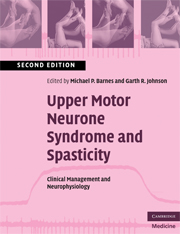Book contents
- Frontmatter
- Contents
- List of Contributors
- Preface to the second edition
- 1 An overview of the clinical management of spasticity
- 2 Neurophysiology of spasticity
- 3 The measurement of spasticity
- 4 Physiotherapy management of spasticity
- 5 Seating and positioning
- 6 Orthoses, splints and casts
- 7 Pharmacological management of spasticity
- 8 Chemical neurolysis in the management of muscle spasticity
- 9 Spasticity and botulinum toxin
- 10 Intrathecal baclofen for the control of spinal and supraspinal spasticity
- 11 Surgical management of spasticity
- 12 Management of spasticity in children
- Index
- References
5 - Seating and positioning
Published online by Cambridge University Press: 22 August 2009
- Frontmatter
- Contents
- List of Contributors
- Preface to the second edition
- 1 An overview of the clinical management of spasticity
- 2 Neurophysiology of spasticity
- 3 The measurement of spasticity
- 4 Physiotherapy management of spasticity
- 5 Seating and positioning
- 6 Orthoses, splints and casts
- 7 Pharmacological management of spasticity
- 8 Chemical neurolysis in the management of muscle spasticity
- 9 Spasticity and botulinum toxin
- 10 Intrathecal baclofen for the control of spinal and supraspinal spasticity
- 11 Surgical management of spasticity
- 12 Management of spasticity in children
- Index
- References
Summary
Introduction
Spasticity causes seating challenges for a wide variety of people with disabilities: from children with cerebral palsy, young adults with head injuries, middle-aged people with multiple sclerosis (MS) and older persons who have suffered cerebrovascular accidents (CVAs) and use wheelchairs.
The nature of spasticity is complex and controversial, as discussed elsewhere in this volume. Clinical characteristics described as constituting spasticity and that influence seating include increased muscle tone, hyperactive stretch reflexes, changes in muscle structure and function and abnormal activity caused by posture (e.g. tonic neck and labyrinthine reflexes) (Ford, 1986; Shepherd, 1995).
Spasticity, in itself, is not necessarily a problem and may assist in maintaining a seated posture. This is in contrast to hypotonia, where providing seated support in a functional position is often very difficult. However, there are three key problems that spasticity can cause to the person in a seated position:
Postural instability
Reduced upper limb function
Joint contractures
Correct positioning of the person can assist in reducing these problems (Zollars, 1993). Addressing one of the areas has a largely beneficial effect on the others, so there is little trade-off in strategies to tackle these problems. Barnes (1993) states: ‘positioning of the individual is the most important element in the management of spasticity’(see also Vaughan & Bhakta, 1995).
Appropriate seating should be seen as adjunct to the other approaches discussed in this book which may have greater precedence with increasing severity of spasticity (e.g. pharmacological, surgical) (Richardson & Thompson, 1999).
Keywords
- Type
- Chapter
- Information
- Upper Motor Neurone Syndrome and SpasticityClinical Management and Neurophysiology, pp. 99 - 112Publisher: Cambridge University PressPrint publication year: 2008
References
- 1
- Cited by

